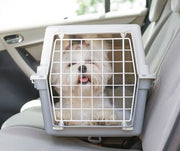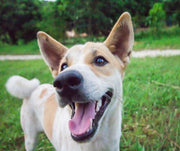Strange Dog Behaviors & Instincts

Dog lovers worldwide would agree that nothing beats the feeling and excitement of going home and seeing your pet greet you with all his enthusiasm, kisses, and tail wags.
But have you ever wondered why their tail wags each time you step into your home? Have you ever wondered why you see your dog circling a specific spot before laying down comfortably?
If you answered yes, then this article is for you!
Dogs have several natural behaviors and instincts, and this doesn't come off as a surprise to the general population of pet parents. Despite understanding that our dogs inherited behaviors passed down from their wolf ancestors, we still find plenty of them to be amusing, and sometimes even strange. In this feature, we will be talking about some commonly cited dog behaviors and instincts and what they usually indicate.
Let's get right into it!
WHAT ARE INSTINCTIVE BEHAVIORS?
Generally, dogs are often straightforward and very friendly, if properly trained. If you own a dog, chances are that you've already observed their cool, calm, and collected behavior. However, others tend to chase their tails more often, and some breeds even have a tendency to be hyper.
Because of this, it is often hard for humans to identify and understand a dog's body language and social cues. Some of these body languages and cues are called instinctive behaviors. Instinctive Behaviors or instincts are traits and characteristics that dogs are born with. It's simply what's in their DNA! Instincts play a variety of roles in a dog's life. Take digging holes, for example. This is a common behavior, as it allows the dog to cover up their food for a prolonged period of time and eventually consume it at a later time.
These natural instinctive behaviors also speak volumes to how your dog wants to be treated. It can be their way of communicating to their owners, or even to other animals, too!
With all that out of the way, let's look at some common dog instincts and behaviors that you've probably already seen a hundred times!
BUTT SNIFFING

As funny as it may seem, this may actually be the most common "strange" behavior in dogs.
Since dogs and humans are different animals, we can never completely understand why dogs exhibit such behavior. But one things is for sure: dogs rely on their sense of smell more often than their other senses.
Generally, people view butt sniffing in dogs as their way of greeting each other. But the reality is, things can get more technical than just "greeting."
Dogs have anal glands, which allows other dogs to collect information like gender or emotional state just by sniffing their bottoms! Not only that, dogs can also identify another dog's reproductive status and even what they had for breakfast! The reason they can do so is because every dog has its own unique scent, similar to a human's fingerprint.
WALKING IN CIRCLES BEFORE LYING DOWN
Imagine heading to bed after an exhausting day, only to walk around compulsively in circles before you allow yourself to snuggle into bed. After all, dogs do it all the time!
This behavior has been passed down from your dog's wolf ancestors. Before they would lie down, they would ensure that other debris, small branches, or leaves were out of the way, leaving behind a nice, comfortable spot for them before falling asleep.
HUMPING AND MOUNTING
Have you ever had someone walk into your place, and your dog immediately humps their leg?
If your dog has already been neutered, this behavior can be brought on for various reasons. Your dog may merely be seeking attention, may be over-excited, or may be trying to find a way to cope with anxiety. Humping can also be a means for a dog to release pent up energy.
If you see your dog gently humping the leg of a guest, it may be their way of greeting them. Despite this, we still recommend discouraging your dog from doing this.
TAIL WAGGING / TAIL CHASING

Dogs need a lot of mental and physical stimulation. Failure to meet these needs and you've got yourself a bored dog who lashes out at the expense of your shoes and furniture.
Dogs usually chase their tail as a means of releasing excess energy. It can be a form of entertaining themselves whenever they get bored. However, be mindful of dogs chasing their tail, as it can sometimes be an indication of them being hurt or injured. For extreme cases, however, some dogs have obsessive-compulsive disorder and can be characterized by their excessive tail chasing.
Tail wagging is also a common means of communication for dogs. Whenever their tail wags, it can often mean two things: happiness or fear.
Dogs generally wag their tail to the right whenever they are excited, such as in our earlier example of greeting you after a long day at work. Whenever anxious or scared on the other hand, dogs tend to wag their tail to the left.
THE WRAP UP
There are hundreds of other strange dog behaviors and instincts that appear inexplicable at first. Thanks to the experts, we have the means to identify if our dog's needs whenever they exhibit such behavior. Just be sure to consult a licensed professional if you notice your dog display an alarming change in behavior. Other than that, these common behaviors should help you communicate with your dog even better and help establish a better bond between you two.
Sources:
Previous article

Next article

Related posts
View all-

What Can You Use Instead of Cat Litter?
Traditional cat litter is convenient, but it’s not the only option. Many cat owners look for alternatives to reduce waste, save money, or avoid chemicals found in clay-based kitty litter. Some options offer better odor control, while others are more eco-friendly or gentler on a cat’s paws.
Read Article -

How to Keep My Backyard Smelling Fresh
A clean backyard should smell fresh, unlike pet waste, smoke, or mold. Bad smells can linger, especially when dog poop, urine, or food scraps attract flies and bacteria. If your yard has a foul odor, it's time to take action. The first step is cleaning up pet feces, trash, or rotting food. A garden hose can wash away dirt and urine from artificial turf, patios, and decks. To neutralize odor, Use baking soda, white vinegar, and essential oils.
Read Article -

What Supplies Do First-Time Cat Owners Need?
Bringing home a new cat is exciting, but making them feel safe and comfortable takes more than love. First-time cat owners must prepare with the right supplies to ensure a smooth transition. From a litter box to cat food and a warm bed, having the basics ready can help your new kitty settle in faster. This guide covers everything a new cat owner needs to make their new pet feel at home.
Read Article



